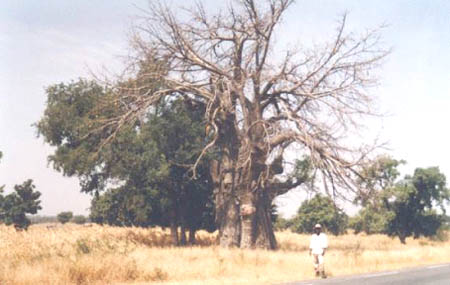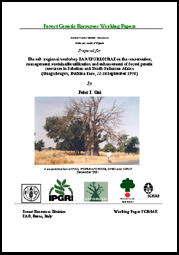

Forest Genetic Resources Working Papers
Prepared for
The sub-regional workshop FAO/IPGRI/ICRAF on the conservation, management, sustainable utilization and enhancement of forest genetic resources in Sahelian and North-Sudanian Africa
(Ouagadougou, Burkina Faso, 22-24 September 1998)
By
Peter I. Oni

A co-publication of FAO, IPGRI/SAFORGEN, DFSC and
ICRAF
December 2001
|
|
|
|
|
|
Working Paper FGR/16E
Forestry Research Institute of Nigeria, Ibadan Nigeria
A co-publication of
Food and Agriculture Organization of the United Nations (FAO)
Sub-Saharan Africa Forest Genetic Resources Programme of the International Plant Genetic Resources Institute (IPGRI/SAFORGEN)
Danida Forest Seed Centre (DFSC) and
International Centre for Research in Agroforestry (ICRAF)
December 2001
Working papers FGR/16E
For further information please contact:
Oscar Eyog-Matig, IPGRI/SAFORGEN Programme
Coordinator
c/o IITA 08 BP 0932 Cotonou, Benin.
Tel.: +229 350188/350553/350600
Fax: +229 350556
E-mail: [email protected]
Citation
Oni P.I. 2001. State of Forest genetic Resources in the dry north of Nigeria. Sub-Regional Workshop FAO/IPGRI/ICRAF on the conservation, management, sustainable utilization and enhancement of forest genetic resources in Sahelian and North-Sudanian Africa (Ouagadougou, Burkina Faso, 22-24 September 1998). Forest Genetic Resources Working Papers, Working Paper FGR/16E. Forestry Department, FAO, Rome, Italy.
Cover. Photo: Oscar Eyog-Matig.
1. SOCIO-ECONOMIC AND ECOLOGICAL CHARACTERISTICS
1.1. Geographic position of the country
1.2. Socio-economic information
1.3. Ecological information
2. STATE OF FOREST GENETIC RESOURCES
2.1. Phytogeography of the country
2.2. Utilization patterns of forest species
2.3. Threats
3.1. In situ conservation activities
3.2. Ex situ conservation activities
3.3. Selection and genetic improvement
3.4. National priority species
4. POLICY, PLANNING AND INSTITUTIONAL MECHANISM
4.1. National forest policy
4.2. Laws and other rules
4.3. Institutions involved in FGR
5. TRAINING AND RESEARCH CAPACITY BUILDING AND REINFORCEMENT
6. REGIONAL AND INTERNATIONAL COOPERATION
Annex 1: Values and use of target, priority species
Annex 2: Management and location of genetic resources by natural site and species